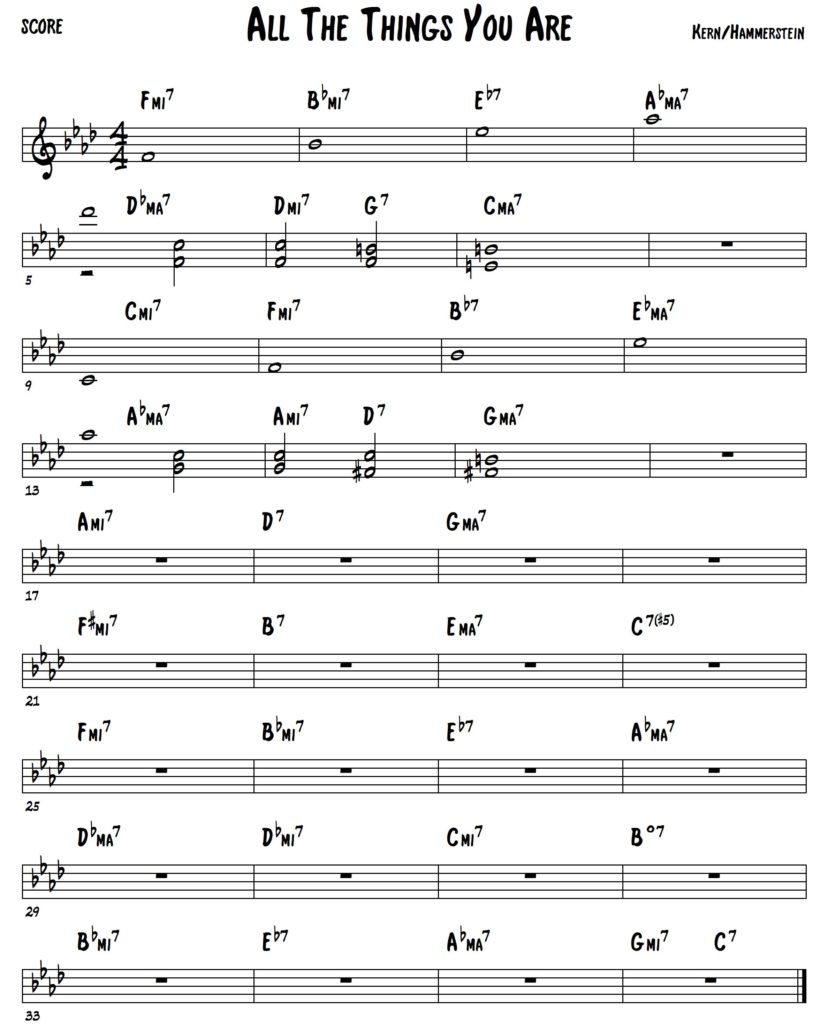All the Things You Are
A very informative resource site for getting the basics for tunes is learnjazzstandards.com
Once there, you can search for a tune and, as in this case, many options for blog entries come up. If you click the link above it will take you to the introductory entry for All the Things You Are. On the right side of the screen are the chord changes in the usual transpositions, and different versions of play-a-longs. A very nice feature is included at the bottom of the article where he posts multiple recordings of the featured tune.
When improvising, the first thing one should get an understanding of is the form. This tune is wonderfully complex, and unfortunately played too often in situations where the players do not have a “real” grasp of the intricacies of the chord structure. A similar comparison can be made to “Stella By Starlight”. In the wrong hands these beautifully complex tunes can sound stale and overplayed. The intent of this post is to hopefully give players a better understanding and some ideas to employ over All the Things.
Form
Notice that bars 1-8 are exactly the same as 9-16, except a fourth apart. This lends opportunity to sequencing, transposing or modulating one idea up a fourth – or not. The third eight-bar section (17-24) could be thought of as a bridge. Here we have two ii-V7-I progressions. One would expect this to be followed by a final eight-bar “A” section. The first four measures of the third section (25-28) behave as we would expect – exactly like the opening four measures, but then there is a four-bar downward chromatic extension (29-32) prior to bringing us home to a nice ii-V7-I in tonic (Ab).
Theory
Let’s dig a little deeper. The tune is in the key of Ab, yet it doesn’t begin with the usual suspects. It starts on the 6th chord tone F-7. The tune is obviously built in four-bar phrases so our first major cadence happens in measure four with tonic Ab. Look what starting on the 6th does to the bass note movement – circle of fourths. This has the effect of making Ab not sound so “tonicky” but rather just another chord in what feels like a logical sequence which adds motion and flow. Kern extends this concept to the 5th bar (Db) then finishes off the phrase with a nice ii-V7-I in C. (Ab Maj > C Maj = Chromatic Mediant – third relationship. Other folks like Beethoven and Coltrane explored this chord relationship in many of their compositions.) Anyway, back to bars 5-8. At first glance, the Db Maj seems somewhat random in relation to the following three measures D-7, G7, C Maj. However, if we think of the TWO MOST IMPORTANT NOTES OF ANY CHORD ARE THE 3rd AND 7th, then it doesn’t seem so random; Db Maj and D-7 share the same 3rd and 7th. The tritone substitution for G7 would be Db7 so there are some relationships there to draw upon as well. Remember that the first eight measures are structurally the same as the next eight so just migrate all this information up a fourth for measures 9-16. Now, this brings us to the bridge. Notice how similar the four bars prior to the bridge are like the first four bars of the bridge. This can sometimes be a confusing moment when improvising! I mentioned earlier that the bridge consisted basically of two ii-V7-I’s. What is their relationship? (more chromatic mediant!)
Final Note
While All the Things You Are is loaded with ii-V7-I’s they are used in such a way (not starting on the first measure of a four-bar phrase) that it makes it difficult to approach this tune with the standard convention of employing ii-V licks and patterns over the proper chords. Rather, I think you will find more success thinking about common chord tones and half-step movement with important chord tones. This tune has more “flow” than many standards I feel, because of the opening root movement of fourths. It doesn’t “feel” like a typical four bar construction. So, using four-bar ideas is forcing an issue on a tune that isn’t quite built that way. Do a quick analysis of what the chord tones are that make up the melody and you will be surprised how many 3rds and 7ths are being used. Let that be your guide, or let those tones be your goals to create a more linear line.

